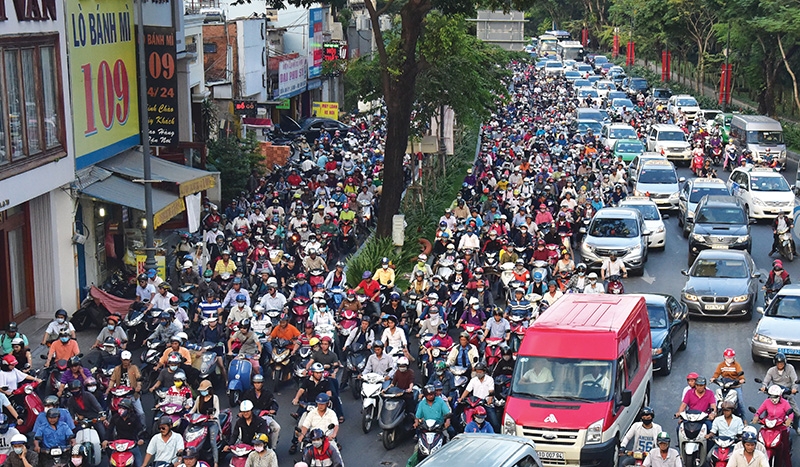Vietnam has been a global success story in how the government responds and controls the pandemic and its impacts on the Vietnamese people’s health and safety. The focus now is very much on economic recovery and turning the pandemic challenge into an opportunity for Vietnam to transfor
 |
| Hanh Le - Country representative for Vietnam, Global Green Growth Institute |
In fact, green economic recovery is a global call, not just for Vietnam. According to the Guardian, more than 200 organisations representing at least 40 million health workers have signed an open letter calling the G20 leaders to ensure a green recovery from the coronavirus crisis that takes account of air pollution and climate breakdown. The letter urges the stimulus packages must include considerations of public health and environmental concerns, warning how environmental degradation could unleash future diseases.
Some countries are considering green recovery measures such as limited support to fossil fuel dependent industries, promotion of low-carbon technologies, better and faster broadband for virtual working, and increased investments in infrastructure contributing to emission reductions such as more bicycle lanes and electric vehicle charging stations.
Vietnam is one of the most vulnerable countries in the world to climate change. Right now, millions of small farms and vulnerable communities in the Mekong Delta are experiencing the worst drought and the longest period of salinity in years, as a result of many reasons amongst which climate change creates a compounding effect. As part of the international efforts in combating climate change, Vietnam is one of 195 signatories to the Paris Agreement, committing to limit the increase in global average temperature to below 2°C.
The Vietnamese government, communicating in its first greenhouse gas (GHG) emission reduction NDC (Nationally Determined Contribution) commitment, has set out the target to reduce Vietnam’s GHG emissions by 8 per cent unconditionally and by 25 per cent with international support. However, these ambitions, as is the case with all NDC commitments globally, will need to be enhanced significantly in order to meet the goal of the Paris Agreement.
The Vietnamese government has made efforts in formulating new policy instruments and revising relevant legislative frameworks (for example amendments to the Law on Environment Protection) to allow for more innovative and cost-effective tools which would incentivise economic sectors and the public at large to “change behaviours” towards more low-carbon technologies and lifestyles.
Carbon tax is one of such policy tools that the Ministry of Finance together with the Ministry of Natural Resources and Environment have considered. The carbon tax can be applied to highly emitting sectors, such as the energy industry (19 per cent of total GHG emissions in Vietnam), cement production (13 per cent), transport (over 11 per cent), and more.
 |
| Vietnam is targeting to reduce greenhouse gases as part of wider global commitments. Photo: Le Toan |
What and why of carbon tax
To limit GHG emissions, there are two broad instruments that governments can use. The first is so-called command-and-control policies, for instance setting performance standards that define the maximum of emissions from certain sectors, processes or activities; or technology standards and product standards. The second is market-based instruments that create economic incentives that change the behaviour of targeted businesses and people, like subsidies, feed-in tariffs, taxes, or tax exemptions.
A carbon tax belongs to the second strategy, putting a price on carbon (expressed as a value such as VND per tonne of carbon being emitted into the atmosphere). This way, the carbon tax would provide a direct financial incentive to emitters to reduce their emissions.
Carbon tax, as a market-based instrument, has a number of advantages over command-and-control policies, including the flexibility it gives to the emitters to find the most cost-effective way to reduce emissions whilst government officials do not have to specify certain sectoral standards that might not catch up with the latest technologies in these sectors.
Carbon tax also has a number of benefits over other economic policies (such as an emission trading mechanism), including providing a stable signal to investors regarding the price of each tonne of carbon emitted to the atmosphere; also, it is more simple administratively to implement as it does not require extra infrastructure such as a trading platform. Carbon tax overall (if collected per tonne of CO2 emitted) is also considered fair as the higher the emissions, the more the emitter has to pay.
Vietnam is not alone in considering a carbon pricing tool such as carbon tax to meet its national targets of GHG emission reduction. Other developed and developing countries have applied domestic carbon taxes on their heavy emitters for over 10 years, using the principle “emitters-pay” to incentivise emission reduction.
China introduced a carbon tax on fossil fuel heavy industries in 2013 and progressed to a national emission trading scheme in 2017. India, another large emerging market, announced a carbon tax on all coal produced in and imported to the country in 2010. This domestic carbon tax is considered as a step towards helping India meet their voluntary target in GHG emission reduction, contributing to the global commitment.
Closer to Vietnam, Singapore has introduced a carbon tax of S$5 ($3.55) per tonne of greenhouse gas emissions since 2018. Other developed countries that have adopted this carbon pricing instrument include France, Denmark, Finland, Norway, South Africa, Switzerland, and the United Kingdom amongst others.
It is expected that Vietnam will at some point introduce an economy-wide instrument to curb its GHG emissions, especially as an increasingly important member of the international community, not only in addressing environmental concerns but also in global trade.
Readiness to apply
The most important factor in order to successfully implement carbon tax is public acceptance. Whilst the rationale for carbon tax is clear, the proposal by the Ministry of Finance to consider a carbon tax has received certain push-back from other ministries and the public as it is considered that Vietnam is not yet ready to implement such a tax.
In order for the carbon tax to be successful, it is important to identify correctly the tax rate to be imposed and how it will be collected. The tax rate will be determined by the cost of reducing a tonne of CO2 emitted into the atmosphere and the targeted amount of reduction that the government would like to achieve.
It is important to impose the tax on the actual emissions to adhere to the principle “emitters pay” which is difficult to implement right now as most of Vietnamese businesses do not have adequate facilities and equipment to measure their CO2 emissions correctly. According to the Ministry of Construction, none of the 82 cement producers under their purview has the capacity to measure their emissions and report the necessary data to the authorities.
Another question that needs to be answered is how the tax revenues will be used. At the moment, it is not yet clear from the proposal as to how the revenues will be spent. It is encouraged that carbon tax revenues will lead to increased spending and investments in low-carbon infrastructure and promoting cleaner and greener technologies.
The third important factor for successful implementation is a clear roadmap for businesses and the people to get ready and prepare to comply with the carbon tax. As mentioned above, many heavy emitting businesses in Vietnam are not yet ready to collect sufficient data of their own GHG emissions.
In addition, it is not clear who would be the relevant authorities to collect and verify such data and if they have the capability to do so. It is essential that the capacity for these government authorities is strengthened as well as a roadmap for emitters who would be subject to the carbon tax.
As Vietnam is committed to reducing its GHG emissions, contributing to the Paris Agreement’s goal of limiting average global temperature increase to well below 2°C, the government is exploring other policy options to incentivise investments, especially from the private sector, towards climate-smart and green solutions.
For example, as part of the international community to combat climate change, Vietnam’s efforts to go beyond its own target will be recognised and can be traded with other countries through an international carbon pricing mechanism provided for by the Article 6 of the Paris Agreement. According to our assessment, Vietnam has a high potential to take part in this international carbon trading mechanism, especially in the energy and agriculture sectors.
Sustainable financing instruments such as green loans and green bonds have also been identified by the government as important ways to incentivise private sector investments into greener and cleaner sectors and technologies. International development partners such as the Global Green Growth Institute, the Asian Development Bank, GIZ, and others have been working closely with the government and the private sector to develop green loan and green bond markets in Vietnam.
As one of the first countries that can reopen the economy thanks to its success in controlling COVID-19 pandemic impacts, the time cannot be more right for Vietnam to transform towards a more sustainable and resilient economy. Choosing the right policy measures is critical in this quest. VIR
Hanh Le

Climate change: older trees loss continue around the world
Every six seconds in 2019 the world lost an area of primary forest the size of a football pitch, a study says.

Delta must have 'emergency plan' on climate change
The Mekong Delta must include an “emergency” response to climate change in its regional planning for the 2021-30 period as rising seas, coastal erosion and subsidence could occur earlier than previously thought, Deputy PM Trinh Dinh Dung said.
 This year marks an important World Environment Day for all of us. More than ever, the COVID-19 pandemic is a somber reminder of why we have to protect our environment in order to protect our health and our economy.
This year marks an important World Environment Day for all of us. More than ever, the COVID-19 pandemic is a somber reminder of why we have to protect our environment in order to protect our health and our economy.